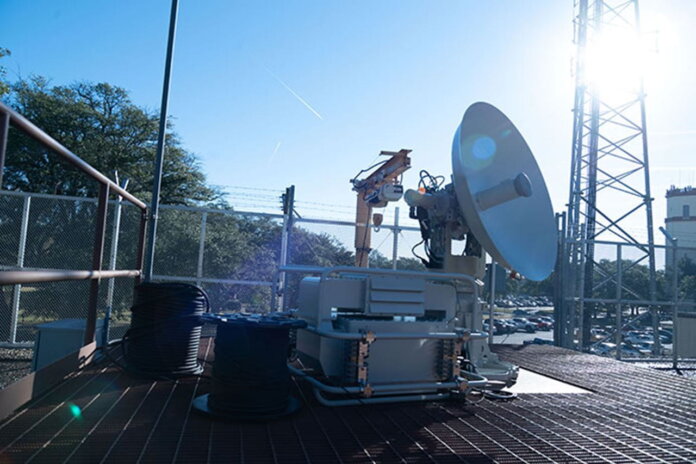
This August the US Air Force declared an initial operational capability for its Global Aircrew Strategic Network Terminal for aircraft and intercontinental ballistic missile units supporting the US nuclear deterrent.
The Global Aircrew Strategic Network Terminal (Global ASNT) carries Extremely High Frequency (EHF) communications. This principally focuses on Ka-band Satellite Communications (SATCOM) on frequencies of 26.5 gigahertz/GHz to 40GHz for uplink and 18GHz to 20GHz for downlink. EHF traffic is carried across the US Department of Defence’s (DOD) Advanced EHF satellite constellation.
The new terminals play a key part in US strategic nuclear communications. As US budgetary documents note, the Global ASNT is a ground-based system. They carry traffic pertinent to the US nuclear deterrent to US Air Force strategic bomber, tanker and reconnaissance aircraft bases supporting the nuclear mission. The air force is also the custodian of the US’ Boeing LGM-30G Minuteman-III intercontinental ballistic missiles. Traffic handled by the terminals includes Emergency Action Messages (EAMs).
EAMs
EAMs are preformatted messages. They direct personnel responsible for nuclear weapons to perform specific actions. EAMs are unencrypted and have a preamble including a codename for the military branch of the intended recipient. For example, open sources state that Sky King messages are intended for all aircraft and ballistic missile units supporting the US nuclear deterrent.
EAMS consist of a series of letters corresponding with the North Atlantic Treaty Organisation’s (NATO’s) phonetic alphabet, such as ‘Alpha’, ‘Bravo’ and ‘Charlie’ etcetera. To the causal listener, these letters are meaningless. However, aircraft or missile crews will translate them into the actions they are to perform. EAMs are typically 30 characters long but on occasions have been up to 200 characters in length. The open source numbers-stations.com website is an excellent resource providing an overview of EAMs.
The new terminals are needed as the DOD’s MILSTAR communications satellites are approaching the end of their lives. These satellites provide K-band (18GHz to 27GHz) downlinks and Ka-band uplinks and carry EAM traffic. MILSTAR is being replaced by AEHF. The carriage of EAMs over SATCOM carried across MILSTAR and AEHF forms part of the US Minimum Essential Emergency Communications Network (MEECN). MEECN is the conduit for US president and national command authorities to share EAMs with the nuclear deterrent. Global ASNT is compatible with both MILSTAR and AEHF waveforms. However, current MILSTAR terminals cannot use the AEHF waveform.
Global ASNT
Raytheon began work on the Global ASNT in 2013 after the award of a contract covering the provision of the system, associated training and Maintenance, Repair and Overhaul (MRO) support. Christopher Noth, the company’s director for ground and maritime protected communications systems programmes, told Armada that the Global ASNT architecture includes an antenna, antenna controller, mission equipment and cabinets, and power systems. The terminals take the form of a fixed installation. Mr. Noth said that the Global ASNT is available in both fixed and transportable versions. Although the terminals handle nuclear deterrent traffic, they will also carry other traffic across the AEHF constellation pertaining to non-nuclear missions.
Raytheon is under contract to provide 90 terminals in fixed and transportable versions. Open sources say these are split equally between transportable and fixed terminals. Mr. Noth expects completion of the Global ASNT contract by 2024 predicting the terminals will have a life span of circa 20 years.
The concept of operations for the Global ASNT is for it to receive EAMs across the Ka-band links backhauled over the AEHF constellation. After EAMs reach Earth, they are sent onwards to nuclear units. This is done using High Frequency (HF: three megahertz/MHz to 30MHz) and Ultra High Frequency (UHF: 300MHz to three gigahertz) links. The overall Global ASNT programme comprises two parts. Increment-1 covers the EHF terminal provision. Increment-2 covers the provision of other communications handling non-SATCOM nuclear traffic which will be subject of future Armada articles.
by Dr. Thomas Withington












